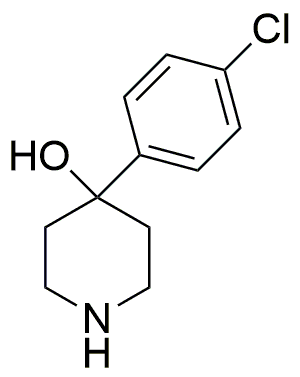4-(4-Chlorophenyl)-4-hydroxypiperidine is widely utilized in research focused on:
- Pharmaceutical Development: This compound serves as a key intermediate in the synthesis of various pharmaceuticals, particularly in the development of analgesics and antidepressants, enhancing therapeutic efficacy.
- Neuroscience Research: It is used in studies investigating neurotransmitter systems, helping researchers understand the mechanisms behind mood disorders and potential treatments.
- Analytical Chemistry: The compound is employed in the formulation of analytical standards for chromatography, aiding in the accurate detection and quantification of related substances in complex mixtures.
- Material Science: Its unique properties make it suitable for creating specialized polymers and coatings, which are used in electronics and protective materials.
- Biochemical Assays: This chemical is utilized in various biochemical assays to evaluate the activity of enzymes and receptors, providing insights into drug interactions and biological pathways.
Informations générales
Propriétés
Sécurité et réglementation
Applications
4-(4-Chlorophenyl)-4-hydroxypiperidine is widely utilized in research focused on:
- Pharmaceutical Development: This compound serves as a key intermediate in the synthesis of various pharmaceuticals, particularly in the development of analgesics and antidepressants, enhancing therapeutic efficacy.
- Neuroscience Research: It is used in studies investigating neurotransmitter systems, helping researchers understand the mechanisms behind mood disorders and potential treatments.
- Analytical Chemistry: The compound is employed in the formulation of analytical standards for chromatography, aiding in the accurate detection and quantification of related substances in complex mixtures.
- Material Science: Its unique properties make it suitable for creating specialized polymers and coatings, which are used in electronics and protective materials.
- Biochemical Assays: This chemical is utilized in various biochemical assays to evaluate the activity of enzymes and receptors, providing insights into drug interactions and biological pathways.
Documents
Fiches de données de sécurité (FDS)
La FDS fournit des informations de sécurité complètes sur la manipulation, le stockage et l’élimination du produit.
Spécifications du produit (PS)
Le PS fournit une description complète des propriétés du produit, notamment sa composition chimique, son état physique, sa pureté et les exigences de stockage. Il détaille également les plages de qualité acceptables et les applications prévues du produit.
Certificats d'analyse (COA)
Recherchez des certificats d'analyse (COA) en saisissant le numéro de lot du produit. Les numéros de lot et de lot se trouvent sur l'étiquette d'un produit, après les mots « Lot » ou « Lot de fabrication ».
Numéro de catalogue
Numéro de lot/série
Certificats d'origine (COO)
Ce certificat d'exploitation confirme le pays dans lequel le produit a été fabriqué, et détaille également les matériaux et composants utilisés et s'il est issu de sources naturelles, synthétiques ou autres sources spécifiques. Ce certificat peut être requis pour les douanes, le commerce et la conformité réglementaire.
Numéro de catalogue
Numéro de lot/série
Fiches de données de sécurité (FDS)
La FDS fournit des informations de sécurité complètes sur la manipulation, le stockage et l’élimination du produit.
DownloadSpécifications du produit (PS)
Le PS fournit une description complète des propriétés du produit, notamment sa composition chimique, son état physique, sa pureté et les exigences de stockage. Il détaille également les plages de qualité acceptables et les applications prévues du produit.
DownloadCertificats d'analyse (COA)
Recherchez des certificats d'analyse (COA) en saisissant le numéro de lot du produit. Les numéros de lot et de lot se trouvent sur l'étiquette d'un produit, après les mots « Lot » ou « Lot de fabrication ».
Numéro de catalogue
Numéro de lot/série
Certificats d'origine (COO)
Ce certificat d'exploitation confirme le pays dans lequel le produit a été fabriqué, et détaille également les matériaux et composants utilisés et s'il est issu de sources naturelles, synthétiques ou autres sources spécifiques. Ce certificat peut être requis pour les douanes, le commerce et la conformité réglementaire.


